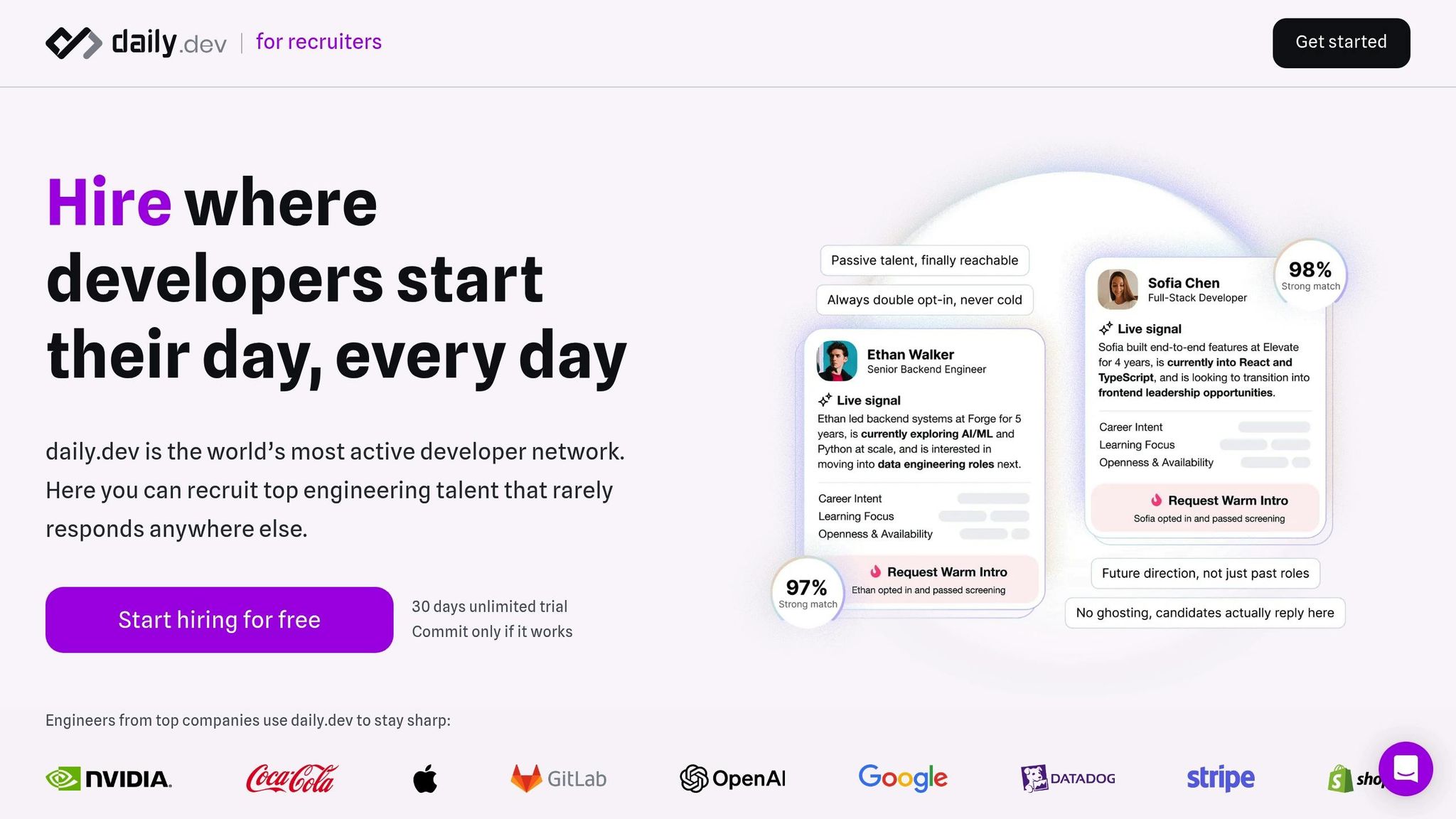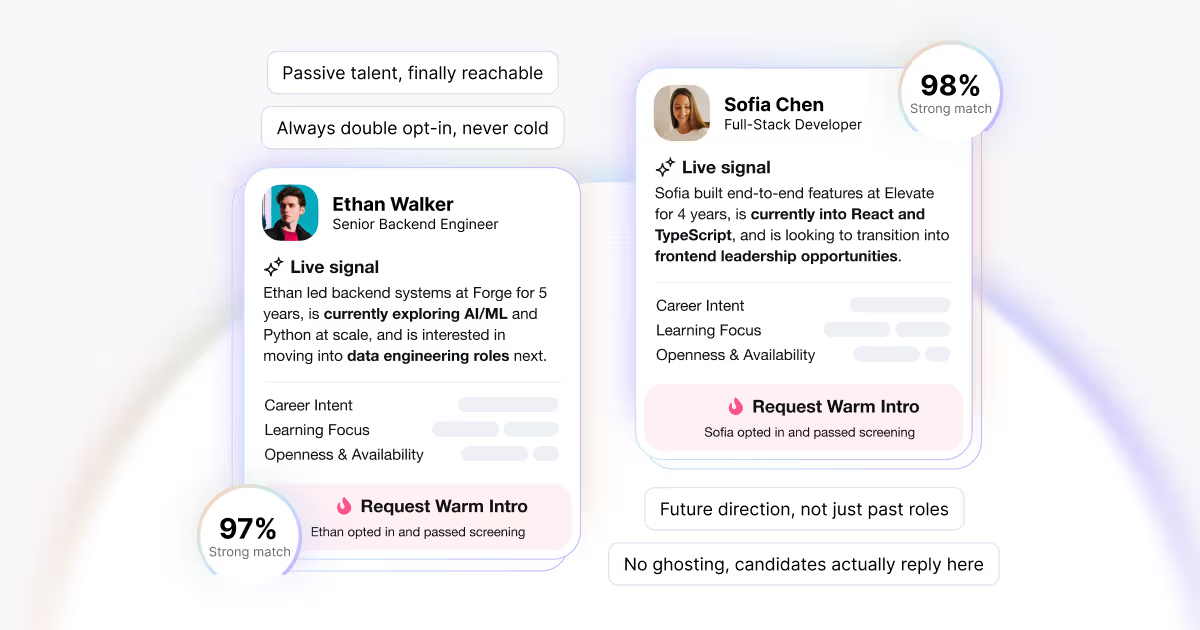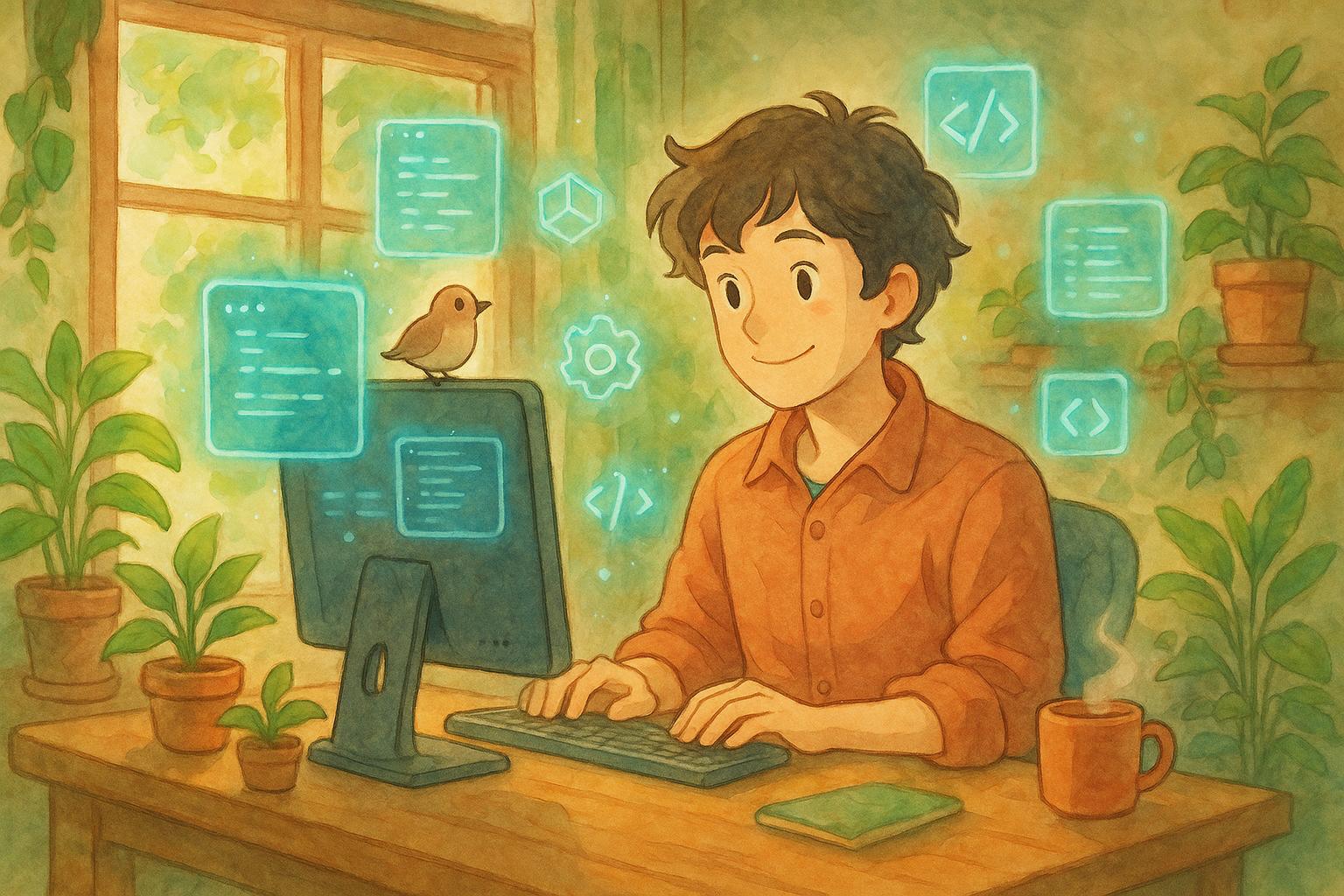


Learn essential strategies for tech recruiting, focusing on building trust, clear communication, and effective candidate engagement.
Tech recruiting is all about speed, precision, and building trust. Developers are in high demand, often juggling multiple offers, so recruiters need to stand out with a genuine, efficient approach. Here's what matters most:
- Understand tech roles: Tailor job descriptions to specific skills (e.g., React for front-end, Python for back-end). Collaborate with technical teams for accuracy.
- Create candidate profiles: Match technical skills with personal motivators. Consider career stages (junior, mid-level, senior) and preferences like remote work.
- Use the right tools: Platforms like daily.dev Recruiter help with pre-qualified candidates, while ATS and automation tools streamline processes.
- Prioritize communication: Be transparent about timelines, provide feedback, discuss salary early, and respond promptly.
- Fair hiring processes: Standardize interviews, use relevant assessments, and minimize bias with anonymous resume reviews.
- Personalized outreach: Reference candidates' achievements, connect roles to their skills, and keep messages concise and respectful.
Recruiting developers requires more than just filling roles - it’s about creating meaningful connections and offering a seamless experience. Speed, clarity, and respect are your competitive edge.
Five Tips To Find and Recruit IT Candidates For High-Tech Companies Faster
Know Your Tech Roles and Target Candidates
To attract the right talent, it's crucial to define specific tech roles and tailor your approach to match the unique motivations of each position.
Write Clear Tech Job Descriptions
Your job descriptions are often the first interaction candidates have with your company, so they need to stand out. Collaborate closely with technical teams to ensure you're capturing the actual requirements of the role - not just a list of buzzwords.
Front-end developers focus on crafting the parts of websites and applications that users interact with directly. Their work shapes the user interface (UI) and user experience (UX). Highlight tools like React, Vue.js, or Angular, and design platforms such as Figma or Sketch to show how their contributions enhance usability and aesthetics.
Back-end developers handle the behind-the-scenes infrastructure, including servers, databases, and systems that keep everything running smoothly. Emphasize areas like scalability, data management, and reliability, and mention technologies such as Node.js, Python, PostgreSQL, or AWS to appeal to candidates who thrive on solving complex, technical challenges.
Full-stack developers bring versatility, working across both front-end and back-end systems. When recruiting for these roles, focus on their ability to engage in a variety of projects, from initial concept to final deployment, showcasing the impact their broad skill set can have.
"A recruiter's understanding of the role impacts the quality of candidates they source. For example, a tech recruiter should have at least basic industry knowledge of programming languages and software development processes in order to refer ideal candidates to the hiring manager." – hirewithnear.com
Effective job descriptions should also include clear, concise bullet points to outline objectives, responsibilities, and qualifications. Avoid unnecessary jargon, but make sure to include key technical terms so qualified candidates can easily identify whether they’re a fit.
Build Target Candidate Profiles
Creating detailed candidate profiles is essential for targeting the right talent. These profiles should combine technical skills with personal motivators, which requires regular input from IT leaders to align with both current needs and long-term goals.
Start by analyzing the backgrounds of high-performing developers on your team. Look at their technical expertise, interests, and learning preferences. This data provides a strong foundation for identifying similar candidates in the market.
Tailor profiles to match career stages. For instance:
- Junior developers are often focused on building foundational skills and growing within their roles.
- Mid-level developers typically seek projects that challenge their abilities without overwhelming them.
- Senior developers require advanced skills like containerization and are drawn to roles with strategic impact.
Stay informed about tech trends by following developer surveys, industry blogs, and team discussions. This ensures your profiles reflect the latest shifts in technology and candidate expectations.
Additionally, consider geographic and work style preferences. Whether candidates prefer remote, hybrid, or in-person roles, understanding these factors helps you align their preferences with your company’s work model.
Finally, use structured interviews and technical assessments to refine and validate your candidate profiles. These tools ensure your approach remains data-driven and effective.
Tools and Platforms for Tech Recruitment
When it comes to recruiting tech talent, the right tools can make all the difference. They simplify outreach, automate repetitive tasks, and help you connect with candidates on platforms they already trust. One standout option is daily.dev Recruiter, which focuses on creating meaningful connections with developers.
Use daily.dev Recruiter for Warm Introductions

daily.dev Recruiter is built to connect you with developers through warm, mutually agreed introductions. This platform is embedded within a thriving network where developers regularly engage for professional growth and stay updated on industry trends. It’s an ideal space for finding candidates who are not just active but also deeply invested in their careers.
Here’s how it works: developers on the platform express interest in exploring opportunities before any outreach happens. This ensures that every conversation begins with mutual interest, avoiding the awkwardness of unsolicited contact. The platform also pre-screens candidates to match your specific criteria, saving you time and effort. Plus, job briefs are written in a way that resonates with developers, using technical language they’re familiar with. This approach builds trust and sets the stage for productive conversations.
Set Up ATS and Automation Tools
Managing multiple tech roles can get overwhelming without the right systems in place. That’s where an Applicant Tracking System (ATS) comes in. It helps you keep candidate information organized, track communications, and stay on top of follow-ups.
Modern ATS platforms often integrate seamlessly with tools like daily.dev Recruiter, allowing candidate data to flow automatically between systems. This reduces manual data entry and ensures every interaction is documented.
Automation tools can handle routine tasks while keeping your communication personal. For instance, you can set up automated responses to applications, share interview scheduling links, and send reminders to hiring managers - all without losing the human touch. Calendar integrations make it easy for candidates to self-schedule interviews, cutting down on back-and-forth emails and speeding up the process.
For technical roles, consider using assessment platforms that integrate with your ATS. These platforms can send coding challenges or technical questionnaires directly to candidates and compile results for easy review. This creates a standardized and objective evaluation process, making it easier to compare candidates.
Lastly, look for tools with robust reporting and analytics features. Metrics like time-to-hire and candidate drop-off rates can provide valuable insights into your recruitment process. By choosing tools that work well together, you can scale your hiring efforts efficiently and effectively.
sbb-itb-d1e6221
Build Trust and Improve Candidate Experience
In today’s competitive job market, tech professionals have no shortage of opportunities. Developers frequently share their recruitment experiences, and a single negative interaction can tarnish your company’s reputation. This makes it harder to attract top talent in the future. Trust is built by treating every candidate as a potential advocate for your brand, whether or not they land the job.
With well-defined candidate profiles and efficient tools, earning trust becomes a cornerstone of hiring the best tech talent. The way candidates are treated during the recruitment process directly influences their decision to accept an offer. Even the most skilled developers will walk away if they feel undervalued or disrespected.
Communicate Clearly and Openly
Set clear expectations from the start. Be upfront about your hiring timeline, interview process, and what candidates can expect at each stage. For example, if your process typically takes three to four weeks, don’t promise a decision within one week. Transparency builds trust.
Keep candidates in the loop with regular updates, even if there’s no major news. A simple message like, “We’re still reviewing applications and expect to decide by Friday,” shows respect for their time and reduces uncertainty. Unfortunately, many recruiters only reach out when they need something, leaving candidates feeling anxious and overlooked.
Provide actionable feedback whenever possible. Instead of vague rejections like, “We’ve decided to move forward with another candidate,” offer specifics: “Your React skills are strong, but we’re seeking someone with more experience in microservices architecture. We encourage you to apply for future frontend roles.” This not only maintains goodwill but also leaves the door open for future opportunities.
Discuss compensation early. Tech professionals expect salary ranges to be mentioned in job postings or initial conversations. Avoid saving this discussion for the final stages, as it wastes time and can feel disingenuous. If there’s budget flexibility, be honest: “The range is $120,000 to $140,000, with room to adjust based on experience.”
Respond promptly to questions and concerns. Developers often juggle multiple offers, and slow communication can signal disinterest or disorganization. Acknowledge inquiries quickly and provide a clear timeline for follow-up. This responsiveness reflects professionalism and respect.
By prioritizing open communication, you create the foundation for a hiring process that feels fair and respectful.
Create Fair and Consistent Hiring Processes
A fair and structured hiring process strengthens the candidate experience. Standardize interview questions and evaluation criteria for each role. Develop a clear interview guide that assesses technical skills, problem-solving abilities, and alignment with team dynamics. This ensures every candidate is evaluated on the same scale.
Use relevant technical assessments that mirror the actual job requirements. For instance, if the role involves building web applications, avoid irrelevant algorithm puzzles. Test your challenges internally to confirm they’re reasonable and can be completed within the allotted time.
Remove bias during initial screenings by using anonymous resume reviews. Exclude names, photos, and other identifying details to focus solely on qualifications, skills, and achievements. This method reduces unconscious bias and ensures candidates are evaluated fairly.
Train your interview team to follow consistent evaluation standards and recognize unconscious bias. Provide clear guidelines on what to look for in candidates and how to assess their qualifications. Equip interviewers with specific questions and criteria to guide their evaluations.
Document decisions with clarity. Instead of writing vague notes like, “Not a good fit,” explain the reasoning: “Lacks experience with distributed systems, which is critical for this role.” This not only helps in providing constructive feedback to candidates but also ensures accountability in the decision-making process.
Offer flexibility in skill assessments. Some developers excel in live coding interviews, while others perform better with take-home assignments. When possible, allow candidates to choose or blend assessment methods to get a well-rounded view of their abilities.
Value candidates’ time by keeping interviews on schedule and minimizing unnecessary rounds. If three interviews are sufficient to make a decision, don’t add a fourth just because it’s part of a standard process. Be accommodating with scheduling, especially for candidates who are balancing a current job and may have limited availability during standard business hours.
Best Practices for Outreach and Engagement
Reaching out effectively is about more than just sending generic messages. It's about forming genuine connections that resonate with developers’ career aspirations. Building on earlier strategies for clear communication and detailed job descriptions, these approaches focus on fostering long-term engagement rooted in trust and openness. Let’s dive into how to craft job offers that grab developers’ attention right away.
Create Attractive Job Offers
Start with the exciting parts of the job - like challenging projects, key technologies, and the role’s overall impact.
Developers want to know what they’ll be working on and why it matters, so lead with these details.
Be upfront about the tech stack and growth opportunities.
Clearly outline the main technologies and frameworks they’ll use. If there’s room to learn new skills or influence technical decisions, make sure to mention it.
Clarify work arrangements and flexibility.
Whether the role is remote, hybrid, or requires in-office days, be clear so candidates can quickly decide if it fits their needs.
Share an authentic glimpse of your engineering culture.
Talk about your team’s real practices, like collaborative code reviews, engaging technical discussions, or time set aside for learning. This helps candidates picture what it’s like to work with your team.
List competitive salary ranges openly.
Including compensation details upfront builds trust and sets clear expectations from the start.
Highlight career progression opportunities.
Explain how the role fits into the larger team, potential paths for advancement, mentorship programs, or other growth opportunities. This helps candidates envision a future with your company.
While crafting compelling job offers is crucial, personal outreach can make all the difference in engaging passive candidates.
Write Personal Messages for Passive Candidates
Take the time to review the candidate’s profile and mention specific, relevant experiences.
Show that you’ve done your homework by referencing their achievements or expertise.
Connect the role to the candidate’s skills and interests.
Tailor your message to highlight how the job aligns with their demonstrated passions or professional strengths.
Keep your initial communication short and focused on value.
Briefly explain why you’re reaching out, what makes the opportunity stand out, and what the next step could be.
Make subject lines personal and meaningful.
Reference something specific about the candidate’s recent work or expertise to show that your outreach isn’t generic.
Acknowledge their current role and situation.
Respect that they might be happy where they are. Frame your message as an invitation to explore an opportunity, not an assumption that they’re looking to leave.
Follow up once with new details, then let it go.
If you don’t hear back, send a single follow-up with additional information. After that, respect their decision to stay silent.
Close with a low-pressure call-to-action.
Offer flexible options for a quick chat or more information, keeping the tone friendly and respectful. This approach shows you value their time and decision-making process.
Conclusion: Key Points for Better Tech Recruiting
Recent data reveals that 73% of talent acquisition professionals experimenting with generative AI believe it will reshape hiring, while 40% of tech hiring leaders see upgrading technology as their top priority for 2025 [4]. The focus is shifting toward meeting candidates on their terms and delivering a seamless experience - principles that are setting the foundation for modern recruitment practices.
Tools like daily.dev Recruiter make it easier to connect with pre-qualified developers, enabling recruiters to prioritize relationship-building over chasing unqualified leads. When paired with advanced ATS systems and AI-powered screening tools, this approach allows for more meaningful and efficient hiring processes.
A key pillar of effective tech recruiting is trust. The industry is moving toward a skills-first approach, with 75% of recruiting professionals planning to prioritize candidates' skills over formal degrees within the next 18 months [4]. This shift reflects a growing emphasis on practical expertise over traditional credentials.
Personalization is another game-changer, as it significantly boosts response rates and elevates recruitment into a strategic process. Acknowledging a candidate's specific projects, understanding their current situation, and tailoring opportunities to their interests can increase response rates by as much as 40% [4]. Platforms that provide rich candidate insights make this level of personalization achievable, transforming recruitment from a numbers-driven task into a thoughtful matchmaking effort.
Adapting to remote and hybrid work models is also crucial. Highlighting flexibility in job descriptions, streamlining virtual interviews, and understanding that top candidates often have multiple options can make a significant difference in attracting the right talent.
FAQs
What are the best ways for tech recruiters to craft job descriptions that attract top candidates?
To create job descriptions that draw in top tech talent, focus on being clear, specific, and engaging. Start by using a data-focused strategy - analyze hiring metrics like application rates to see what works and tweak the language or formatting as needed. Including targeted keywords can also boost visibility in search results while emphasizing the skills and experience required for the position.
Make sure the content is straightforward and to the point. Avoid generic phrases and instead, align the tone with your company's personality and values. You can even use tools like AI to refine descriptions, ensuring they’re inclusive and appealing to a broader audience. By putting thought into your job postings, you’ll connect with the right candidates and inspire them to apply.
How can tools like daily.dev Recruiter improve the tech hiring process?
Using tools like daily.dev Recruiter can transform the tech hiring process by making workflows smoother and boosting recruiter productivity. These tools are designed to help you quickly identify top-tier tech talent, craft personalized outreach messages, and efficiently manage candidate pipelines.
Packed with features specifically designed for tech recruitment, they enable you to build stronger connections with developers, improve response rates, and cut down on time spent on repetitive tasks through automation. This way, you can focus your energy on delivering a great candidate experience and bringing the best talent onto your team.
What are the best ways for recruiters to build trust and enhance the candidate experience during the hiring process?
Recruiters aiming to build trust and deliver a positive experience for candidates should prioritize clarity, personalized communication, and a thoughtful mix of technology and human interaction. Start by being upfront about the hiring process - share details like timelines, job expectations, and salary ranges. This level of transparency helps eliminate confusion and ensures everyone is on the same page.
Providing meaningful, personalized feedback at every step shows candidates they’re valued. While automation can handle repetitive tasks efficiently, it’s essential to balance it with genuine, one-on-one interactions to foster real connections. By focusing on honesty and empathy, recruiters can create a hiring experience that tech professionals will appreciate and trust.






